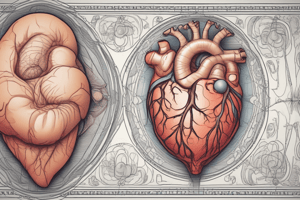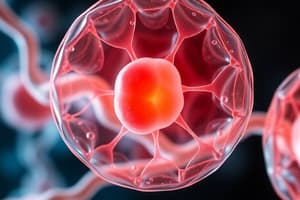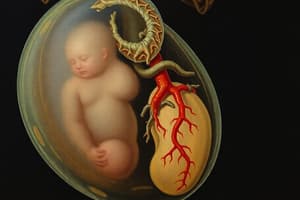Podcast
Questions and Answers
Which of the following is the correct definition of the fetal period?
Which of the following is the correct definition of the fetal period?
- From the 9th week to birth (correct)
- The first 2 weeks after fertilization
- The period from implantation to birth
- From the 3rd week to the 8th week of gestation
Which term refers to the positioning of the fetus with the head down in the uterus?
Which term refers to the positioning of the fetus with the head down in the uterus?
- Transverse presentation
- Breech presentation
- Cephalic presentation (correct)
- Longitudinal presentation
The first trimester of pregnancy spans which weeks?
The first trimester of pregnancy spans which weeks?
- Weeks 1 to 8
- Weeks 1 to 12 (correct)
- Weeks 13 to 24
- Weeks 25 to 40
Which part of the male reproductive system is responsible for the production of sperm?
Which part of the male reproductive system is responsible for the production of sperm?
What is the primary purpose of meiosis in human reproduction?
What is the primary purpose of meiosis in human reproduction?
Which of the following is NOT a phase of meiosis?
Which of the following is NOT a phase of meiosis?
During which phase of meiosis does crossing-over occur?
During which phase of meiosis does crossing-over occur?
At what stage of meiosis does a secondary oocyte arrest until fertilization?
At what stage of meiosis does a secondary oocyte arrest until fertilization?
How many chromosomes does each gamete (sperm or oocyte) contain after meiosis?
How many chromosomes does each gamete (sperm or oocyte) contain after meiosis?
The first step of fertilization is:
The first step of fertilization is:
In response to fertilization, which of the following occurs in the uterus?
In response to fertilization, which of the following occurs in the uterus?
Which structure forms during the second week of embryonic development?
Which structure forms during the second week of embryonic development?
The syncytiotrophoblast is responsible for:
The syncytiotrophoblast is responsible for:
Gastrulation leads to the formation of which primary germ layers?
Gastrulation leads to the formation of which primary germ layers?
Neurulation refers to the formation of which structure?
Neurulation refers to the formation of which structure?
During which week does the primitive heart begin to beat in an embryo?
During which week does the primitive heart begin to beat in an embryo?
The fetal period begins in which week of pregnancy?
The fetal period begins in which week of pregnancy?
During the second trimester, which of the following occurs?
During the second trimester, which of the following occurs?
Which of the following is NOT a fetal membrane?
Which of the following is NOT a fetal membrane?
The placental barrier is made up of which of the following layers?
The placental barrier is made up of which of the following layers?
Which of the following is a known teratogen associated with the development of cleft palate?
Which of the following is a known teratogen associated with the development of cleft palate?
Genetic mutations in which gene are commonly associated with neural tube defects?
Genetic mutations in which gene are commonly associated with neural tube defects?
Which of the following diagnostic tests involves the sampling of cells from the placenta for genetic analysis?
Which of the following diagnostic tests involves the sampling of cells from the placenta for genetic analysis?
Which of the following is the primary purpose of an ultrasound during pregnancy?
Which of the following is the primary purpose of an ultrasound during pregnancy?
A 30-year-old woman is 12 weeks pregnant and presents for her first prenatal visit. She mentions that her previous pregnancy ended in miscarriage during the first trimester. She requests genetic testing. What is the most appropriate diagnostic method for detecting chromosomal abnormalities at this stage?
A 30-year-old woman is 12 weeks pregnant and presents for her first prenatal visit. She mentions that her previous pregnancy ended in miscarriage during the first trimester. She requests genetic testing. What is the most appropriate diagnostic method for detecting chromosomal abnormalities at this stage?
A 35-year-old woman is in her second trimester and undergoes an ultrasound, revealing a neural tube defect. Which of the following genetic abnormalities is most commonly associated with neural tube defects?
A 35-year-old woman is in her second trimester and undergoes an ultrasound, revealing a neural tube defect. Which of the following genetic abnormalities is most commonly associated with neural tube defects?
During the embryonic period, the development of which of the following structures is most sensitive to teratogens?
During the embryonic period, the development of which of the following structures is most sensitive to teratogens?
At which stage of development is the embryo referred to as a blastocyst?
At which stage of development is the embryo referred to as a blastocyst?
The Leydig cells in the testes produce which of the following hormones during fetal development?
The Leydig cells in the testes produce which of the following hormones during fetal development?
Which of the following statements is true about the difference between mitosis and meiosis?
Which of the following statements is true about the difference between mitosis and meiosis?
What is the significance of anaphase I in meiosis?
What is the significance of anaphase I in meiosis?
What is the result of spermatogenesis in terms of the number of functional gametes produced?
What is the result of spermatogenesis in terms of the number of functional gametes produced?
The primary oocyte in females arrests at which stage of meiosis before puberty?
The primary oocyte in females arrests at which stage of meiosis before puberty?
The acrosomal reaction during fertilization allows the sperm to:
The acrosomal reaction during fertilization allows the sperm to:
Following fertilization, the zygote undergoes cleavage. What is the outcome of this process?
Following fertilization, the zygote undergoes cleavage. What is the outcome of this process?
The bilaminar disc consists of which two layers?
The bilaminar disc consists of which two layers?
The trophoblast differentiates into which two layers during the second week of development?
The trophoblast differentiates into which two layers during the second week of development?
In gastrulation, the primitive streak is important for the formation of which of the following?
In gastrulation, the primitive streak is important for the formation of which of the following?
The notochord, which plays a key role in inducing neural development, is derived from which germ layer?
The notochord, which plays a key role in inducing neural development, is derived from which germ layer?
By the end of the fourth week of development, the embryonic heart:
By the end of the fourth week of development, the embryonic heart:
During the fourth week of embryonic development, the somites are responsible for the development of:
During the fourth week of embryonic development, the somites are responsible for the development of:
In the fetal period, the brain undergoes significant development, which begins at which point?
In the fetal period, the brain undergoes significant development, which begins at which point?
The amniotic fluid is produced primarily by:
The amniotic fluid is produced primarily by:
The chorionic villi are important in:
The chorionic villi are important in:
A pregnant woman is exposed to high doses of radiation during her first trimester. Which of the following malformations is most likely to occur?
A pregnant woman is exposed to high doses of radiation during her first trimester. Which of the following malformations is most likely to occur?
A mutation in the FGF8 gene can result in which of the following congenital malformations?
A mutation in the FGF8 gene can result in which of the following congenital malformations?
Amniocentesis is typically performed during which week of pregnancy?
Amniocentesis is typically performed during which week of pregnancy?
Which of the following antenatal diagnostic techniques is non-invasive and used to detect fetal abnormalities by analyzing fetal DNA in maternal blood?
Which of the following antenatal diagnostic techniques is non-invasive and used to detect fetal abnormalities by analyzing fetal DNA in maternal blood?
A 25-year-old woman presents to the clinic for her first prenatal visit at 18 weeks of gestation. She requests genetic testing for Down syndrome. What is the most appropriate non-invasive screening test for her at this stage?
A 25-year-old woman presents to the clinic for her first prenatal visit at 18 weeks of gestation. She requests genetic testing for Down syndrome. What is the most appropriate non-invasive screening test for her at this stage?
A 34-year-old woman who is 10 weeks pregnant presents with concerns about her risk for having a child with a genetic disorder. She has a family history of cystic fibrosis. Which antenatal diagnostic technique would be most appropriate for assessing this risk?
A 34-year-old woman who is 10 weeks pregnant presents with concerns about her risk for having a child with a genetic disorder. She has a family history of cystic fibrosis. Which antenatal diagnostic technique would be most appropriate for assessing this risk?
Which of the following is a key characteristic of the fetal period?
Which of the following is a key characteristic of the fetal period?
The transition from the embryonic to fetal period occurs at:
The transition from the embryonic to fetal period occurs at:
Which of the following is the main difference between anaphase of mitosis and anaphase I of meiosis?
Which of the following is the main difference between anaphase of mitosis and anaphase I of meiosis?
Which of the following phases in meiosis is characterized by crossing-over between homologous chromosomes?
Which of the following phases in meiosis is characterized by crossing-over between homologous chromosomes?
During oogenesis, the secondary oocyte is arrested in which stage of meiosis before fertilization?
During oogenesis, the secondary oocyte is arrested in which stage of meiosis before fertilization?
Spermatogenesis results in the production of how many functional sperm cells from one primary spermatocyte?
Spermatogenesis results in the production of how many functional sperm cells from one primary spermatocyte?
During implantation, the blastocyst attaches to the endometrial lining through which layer?
During implantation, the blastocyst attaches to the endometrial lining through which layer?
The extra-embryonic mesoderm contributes to the formation of which structure during the second week?
The extra-embryonic mesoderm contributes to the formation of which structure during the second week?
. Which of the following structures forms from the epiblast during the second week of development?
. Which of the following structures forms from the epiblast during the second week of development?
Flashcards
Fetal Period
Fetal Period
The period from the 9th week of gestation to birth, characterized by rapid growth and maturation of organs.
Cephalic Presentation
Cephalic Presentation
The positioning of the fetus with its head down in the uterus, signifying the ideal position for vaginal delivery.
First Trimester
First Trimester
The first 12 weeks of pregnancy, encompassing the embryonic period and the early stages of fetal development.
Mesonephric Duct (Males)
Mesonephric Duct (Males)
Signup and view all the flashcards
Mullerian Duct (Females)
Mullerian Duct (Females)
Signup and view all the flashcards
Testes
Testes
Signup and view all the flashcards
Meiosis
Meiosis
Signup and view all the flashcards
Prophase I (Meiosis)
Prophase I (Meiosis)
Signup and view all the flashcards
Metaphase II (Meiosis)
Metaphase II (Meiosis)
Signup and view all the flashcards
Chromosome Number in Gametes
Chromosome Number in Gametes
Signup and view all the flashcards
Acrosomal Reaction
Acrosomal Reaction
Signup and view all the flashcards
Uterine Mucosa Thickening
Uterine Mucosa Thickening
Signup and view all the flashcards
Amniotic Cavity
Amniotic Cavity
Signup and view all the flashcards
Syncytiotrophoblast
Syncytiotrophoblast
Signup and view all the flashcards
Gastrulation
Gastrulation
Signup and view all the flashcards
Neurulation
Neurulation
Signup and view all the flashcards
Week 3 of Embryonic Development
Week 3 of Embryonic Development
Signup and view all the flashcards
Week 4 of Embryonic Development
Week 4 of Embryonic Development
Signup and view all the flashcards
Fetal Membranes
Fetal Membranes
Signup and view all the flashcards
Placental Barrier
Placental Barrier
Signup and view all the flashcards
Teratogen
Teratogen
Signup and view all the flashcards
Sonic Hedgehog (SHH) Gene
Sonic Hedgehog (SHH) Gene
Signup and view all the flashcards
Chorionic Villus Sampling
Chorionic Villus Sampling
Signup and view all the flashcards
Non-invasive Prenatal Testing (NIPT)
Non-invasive Prenatal Testing (NIPT)
Signup and view all the flashcards
Ultrasound
Ultrasound
Signup and view all the flashcards
Fetal Period
Fetal Period
Signup and view all the flashcards
Transition from Embryonic to Fetal Period
Transition from Embryonic to Fetal Period
Signup and view all the flashcards
Mullerian Ducts (Females)
Mullerian Ducts (Females)
Signup and view all the flashcards
Wolffian Ducts (Males)
Wolffian Ducts (Males)
Signup and view all the flashcards
Anaphase I (Meiosis)
Anaphase I (Meiosis)
Signup and view all the flashcards
Spermatogenesis
Spermatogenesis
Signup and view all the flashcards
First Meiotic Division (Oogenesis)
First Meiotic Division (Oogenesis)
Signup and view all the flashcards
Fertilization
Fertilization
Signup and view all the flashcards
Zona Pellucida
Zona Pellucida
Signup and view all the flashcards
Sertoli Cells
Sertoli Cells
Signup and view all the flashcards
Epiblast and Hypoblast
Epiblast and Hypoblast
Signup and view all the flashcards
Notochord
Notochord
Signup and view all the flashcards
Somite Formation
Somite Formation
Signup and view all the flashcards
Week 4 of Embryonic Development
Week 4 of Embryonic Development
Signup and view all the flashcards
Day 22 of Embryonic Development
Day 22 of Embryonic Development
Signup and view all the flashcards
Fetal Period
Fetal Period
Signup and view all the flashcards
Placenta
Placenta
Signup and view all the flashcards
Amniotic Fluid
Amniotic Fluid
Signup and view all the flashcards
Down Syndrome
Down Syndrome
Signup and view all the flashcards
Fetal Alcohol Syndrome
Fetal Alcohol Syndrome
Signup and view all the flashcards
Amniocentesis
Amniocentesis
Signup and view all the flashcards
Non-invasive Prenatal Testing (NIPT)
Non-invasive Prenatal Testing (NIPT)
Signup and view all the flashcards
Study Notes
Fetal Development
- Fetal Period: The period from the 9th week of gestation to birth.
- First Trimester: Weeks 1-12 of pregnancy.
- Cephalic Presentation: The fetus' head is positioned down in the uterus.
- Mesonephric Ducts (Males): Develop into the vas deferens.
- Mullerian Ducts (Females): Develop into the uterus.
- Sperm Production: Occurs in the testes.
- Meiosis: The process of cell division that produces gametes (sperm or egg).
- Meiosis I Phases: Prophase I (crossing-over occurs), Metaphase I, Anaphase I (homologous chromosomes separate), and Telophase I.
- Meiosis II Phases: Prophase II, Metaphase II, Anaphase II (sister chromatids separate), Telophase II.
- Gamete Chromosome Number: 23 chromosomes.
- Fertilization Steps: Sperm penetrates the egg's cytoplasm; the sperm undergoes the acrosomal reaction; the fertilized egg begins mitosis, and the zygote implants in the uterine lining.
- Uterine Changes: The uterine mucosa thickens in response to fertilization.
- Embryonic Development Structure: Amniotic cavity forms in the second week of embryonic development.
- Germ Layers: Ectoderm, Mesoderm, Endoderm.
- Neural Tube Formation: Occurs during neurulation.
- Heart Beat: Begins around week 3.
- Limb Formation: First sign occurs during week 4.
- Second Trimester Characteristics: Rapid weight gain, and fat deposition; development of heart chambers.
- Fetal Membranes (Not a Fetal Membrane): Placenta.
- Fetal Membranes: Amnion, Chorion, Allantois.
- Placental Barrier: Syncytiotrophoblast and cytotrophoblast.
- Teratogens: Substances that can cause birth defects, such as alcohol, thalidomide, and retinoic acid.
- Fetal Period Organ System: Respiratory system.
- Amniotic Fluid Production: Primarily by fetal kidneys.
- Embryonic Periods: The development of the brain and initial stages of organs.
- Chorionic Villi: Important for nutrient exchange, and producing hCG.
- Prenatal Testing:
- Ultrasound: Used to assess fetal development and size, fetal structure.
- Chorionic Villus Sampling (CVS): Done during 12-14 weeks for genetic abnormalities.
- Amniocentesis: Done in the 15-20 weeks for genetic disorders.
- Non-invasive Prenatal Testing (NIPT): Analyzes fetal DNA in maternal blood for genetic analysis.
- Carrier Screening: Identifies if a parent carries a genetic trait that could affect the baby.
- Genetic Disorders: Conditions caused by genetic mutations, such as Neural Tube Defects, Down Syndrome, Spina Bifida, Cleft Lip and Palate, Cystic Fibrosis et al..
- Maternal Age and Genetic Conditions: Down syndrome is often associated with older mothers.
- Abnormal Placenta Location: Low-lying placenta in the 20 weeks of pregnancy. This may result in early-term labor.
- Fetal Length at 3rd Trimester End: Approximately 50 cm.
- Structure Responsible for Nutrient/Waste Exchange: Placenta.
- Amniotic Fluid Function: Cushions the fetus; helps maintain a constant temperature, assists in lung development.
- First Event after Fertilization: Activation of egg metabolism.
- Attachment Site in Implantation: Syncytiotrophoblast.
- Umbilical Cord Composition: One artery and two veins.
- Teratogen Associated with Limb Defects: Thalidomide.
- Teratogen Associated with Cleft Palate: Retinoic acid
Studying That Suits You
Use AI to generate personalized quizzes and flashcards to suit your learning preferences.




